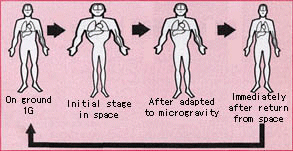EVOLUTION
Evolution
can be defined as the process by which
different kinds of living organisms are thought to have developed and
diversified from earlier forms during the history of the earth. It
can also be defined as a change
in heritable traits of biological populations over successive
generations. Evolutionary processes give rise to diversity at every
level of biological organization, including the level of species,
individual organisms, and at the level of molecular evolution.
Human
evolution is the lengthy process of change by which people originated
from apelike ancestors. Scientific evidence shows that the physical
and behavioral traits shared by all people originated from apelike
ancestors and evolved over a period of approximately six million
years.
One
of the earliest defining human traits, bipedalism -- the ability to
walk on two legs -- evolved over 4 million years ago. Other important
human characteristics -- such as a large and complex brain, the
ability to make and use tools, and the capacity for language --
developed more recently. Many advanced traits -- including complex
symbolic expression, art, and elaborate cultural diversity -- emerged
mainly during the past 100,000 years.
Humans
are primates. Physical and genetic similarities show that the modern
human species, Homo sapiens,
has a very close relationship to another group of primate species,
the apes. Humans and the great apes (large apes) of Africa --
chimpanzees (including bonobos, or so-called “pygmy chimpanzees”)
and gorillas -- share a common ancestor that lived between 8 and 6
million years ago. Humans first evolved in Africa, and much of human
evolution occurred on that continent. The fossils of early humans who
lived between 6 and 2 million years ago come entirely from Africa.
Most
scientists currently recognize some 15 to 20 different species of
early humans. Scientists do not all agree, however, about how these
species are related or which ones simply died out. Many early human
species -- certainly the majority of them – left no living
descendants. Scientists also debate over how to identify and classify
particular species of early humans, and about what factors influenced
the evolution and extinction of each species.
 Early
humans first migrated out of Africa into Asia probably between 2
million and 1.8 million years ago. They entered Europe somewhat
later, between 1.5 million and 1 million years. Species of modern
humans populated many parts of the world much later. For instance,
people first came to Australia probably within the past 60,000 years
and to the Americas within the past 30,000 years or so.
Early
humans first migrated out of Africa into Asia probably between 2
million and 1.8 million years ago. They entered Europe somewhat
later, between 1.5 million and 1 million years. Species of modern
humans populated many parts of the world much later. For instance,
people first came to Australia probably within the past 60,000 years
and to the Americas within the past 30,000 years or so.
The
beginnings of agriculture and the rise of the first civilizations
occurred within the past 12,000 years.
Paleoanthropology
Paleoanthropology
is the scientific study of human evolution. Paleoanthropology is a
subfield of anthropology, the study of human culture, society, and
biology. The field involves an understanding of the similarities and
differences between humans and other species in their genes, body
form, physiology, and behavior. Paleoanthropologists search for the
roots of human physical traits and behavior. They seek to discover
how evolution has shaped the potentials, tendencies, and limitations
of all people.
Early
human fossils and archeological remains offer the most important
clues about this ancient past. These remains include bones, tools and
any other evidence (such as footprints, evidence of hearths, or
butchery marks on animal bones) left by earlier people. Usually, the
remains were buried and preserved naturally. They are then found
either on the surface (exposed by rain, rivers, and wind erosion) or
by digging in the ground. By studying fossilized bones, scientists
learn about the physical appearance of earlier humans and how it
changed. Bone size, shape, and markings left by muscles tell us how
those predecessors moved around, held tools, and how the size of
their brains changed over a long time. Archeological evidence refers
to the things earlier people made and the places where scientists
find them. By studying this type of evidence, archeologists can
understand how early humans made and used tools and lived in their
environments.
The
process of evolution
The
process of evolution involves a series of natural changes that cause
species (populations of different organisms) to arise, adapt to the
environment, and become extinct. All species or organisms have
originated through the process of biological evolution. In animals
that reproduce sexually, including humans, the term species refers to
a group whose adult members regularly interbreed, resulting in
fertile offspring -- that is, offspring themselves capable of
reproducing. Scientists classify each species with a unique, two-part
scientific name. In this system, modern humans are classified as Homo
sapiens.
Evolution
occurs when there is change in the genetic material -- the chemical
molecule, DNA -- which is inherited from the parents, and especially
in the proportions of different genes in a population. Genes
represent the segments of DNA that provide the chemical code for
producing proteins. Information contained in the DNA can change by a
process known as mutation. The way particular genes are expressed –
that is, how they influence the body or behavior of an organism --
can also change. Genes affect how the body and behavior of an
organism develop during its life, and this is why genetically
inherited characteristics can influence the likelihood of an
organism’s survival and reproduction.
Evolution
does not change any single individual. Instead, it changes the
inherited means of growth and development that typify a population (a
group of individuals of the same species living in a particular
habitat). Parents pass adaptive genetic changes to their offspring,
and ultimately these changes become common throughout a population.
As a result, the offspring inherit those genetic characteristics that
enhance their chances of survival and ability to give birth, which
may work well until the environment changes. Over time, genetic
change can alter a species' overall way of life, such as what it
eats, how it grows, and where it can live. Human evolution took place
as new genetic variations in early ancestor populations favored new
abilities to adapt to environmental change and so altered the human
way of life.
The
big question I now ask
is;
-since
biologists and scientists
say that we evolved from apes millions of years ago, what
do those ancient apes evolve from?
-what will the current apes
on the planet evolve to in 100
thousand years’ time?
-Also
since evolution is allegedly the case,
what then will the current humans
evolve to in a
million years to come ? or
even aliens evolved from what ?
If Charles Darwin cannot
wake and answer these
questions, or any other
modern scientists cannot, then
maybe evolution is just some big scientific hoax.
by Osuji Chukwunonso ( group C)











